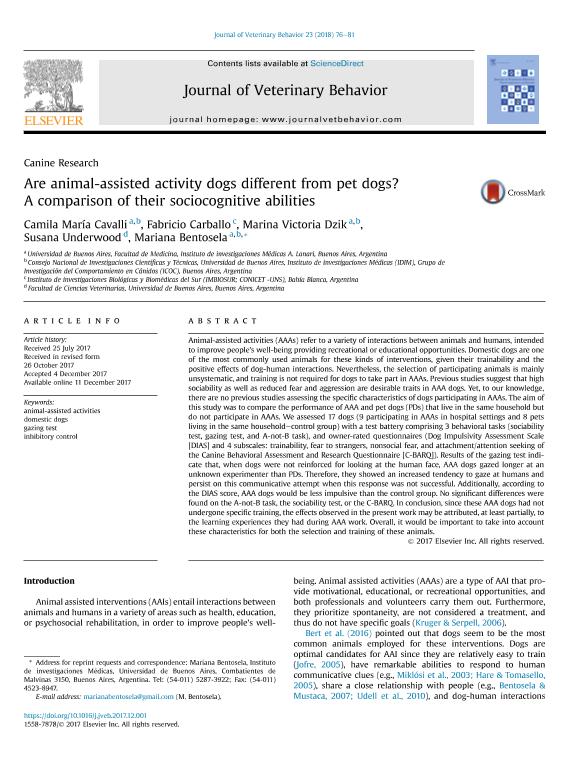Artículo
Are animal-assisted activity dogs different from pet dogs? A comparison of their sociocognitive abilities
Cavalli, Camila María ; Carballo Pozzo Ardizzi, Fabricio
; Carballo Pozzo Ardizzi, Fabricio ; Dzik, Marina Victoria; Underwood, Susana; Bentosela, Mariana
; Dzik, Marina Victoria; Underwood, Susana; Bentosela, Mariana
 ; Carballo Pozzo Ardizzi, Fabricio
; Carballo Pozzo Ardizzi, Fabricio ; Dzik, Marina Victoria; Underwood, Susana; Bentosela, Mariana
; Dzik, Marina Victoria; Underwood, Susana; Bentosela, Mariana
Fecha de publicación:
01/2018
Editorial:
Elsevier Science Inc
Revista:
Journal Of Veterinary Behavior-clinical Applications And Research
ISSN:
1558-7878
Idioma:
Inglés
Tipo de recurso:
Artículo publicado
Clasificación temática:
Resumen
Animal assisted activities (AAA) refer to a variety of interactions between animals and humans, intended to improve people?s wellbeing providing recreational or educational opportunities. Domestic dogs are one of the most commonly used animals for these kinds of interventions, given their trainability and the positive effects of dog-human interactions. Nevertheless, the selection of participating animals is mainly unsystematic and training is not required for dogs to take part in AAA. Previous studies suggest that high sociability as well as reduced fear and aggression are desirable traits in AAA dogs. Yet, to our knowledge, there are no previous studies assessing the specific characteristics of dogs participating in AAA. The aim of this study is to compare the performance of AAA and pet dogs that live in the same household but do not participate in AAA. We assessed 17 dogs (9 participating in AAA in hospital settings, and 8 pets living in the same household ? control group) with a test battery comprising three behavioral tasks (sociability test, gazing test, and A-not-B task), and owner rated questionnaires (Dog Impulsivity Assessment Scale, ?DIAS?, and 4 subscales: Trainability, Fear to Strangers, Nonsocial fear and Attachment/Attention seeking of the Canine Behavioral Assessment and Research Questionnaire, ?C-BARQ?). Results of the gazing test indicate that, when dogs were not reinforced for looking at the human face, AAA dogs gazed longer at an unknown experimenter than pet dogs. Therefore, they showed an increased tendency to gaze at humans and persist on this communicative attempt when this response was not successful. Additionally, according to the DIAS score, AAA dogs would be less impulsive than the control group. No significant differences were found on the A-not-B task, the sociability test or CBARQ questionnaire. In conclusion, since these AAA dogs had not undergone specific training, the effects observed in the present work may be attributed, at least partially, to the learning experiences they had during AAA work. Overall, it would be important to take into account these characteristics for both the selection and training of these animals.
Palabras clave:
Animal
,
Assisted
,
Activities
,
Domestic
,
Dogs
,
Gazing
,
Test
,
Inhibitory
,
Control
Archivos asociados
Licencia
Identificadores
Colecciones
Articulos(IDIM)
Articulos de INST.DE INVEST.MEDICAS
Articulos de INST.DE INVEST.MEDICAS
Citación
Cavalli, Camila María; Carballo Pozzo Ardizzi, Fabricio; Dzik, Marina Victoria; Underwood, Susana; Bentosela, Mariana; Are animal-assisted activity dogs different from pet dogs? A comparison of their sociocognitive abilities; Elsevier Science Inc; Journal Of Veterinary Behavior-clinical Applications And Research; 23; 1-2018; 76-81
Compartir
Altmétricas



